Eat this plant.

It’s garlic mustard.
Eat as much of it as you can.
(This is where you imagine intense music playing in the background.)
Um, okay, Tracey, sure, whatever you say.
No, I’m serious; eat it.
If you could see me right now, you’d know I’m giving you my serious face…which tends to give other people the giggles. (I’m going to have to work on that.)
But you should grab garlic mustard every time you see it and bring it home to eat.
Why?
Well, the most important reason why is because it’s an invasive species. A really invasive species.
Alliaria petiolate, or garlic mustard, is native to Europe, but it sure does like it here in the United States. Every year it’s becoming more widespread and invading new spaces. And once it’s there, it seems to be impossible to get rid of it.
It’s bad enough when an invasive species crowds out native plants, but this one is a force to be reckoned with.
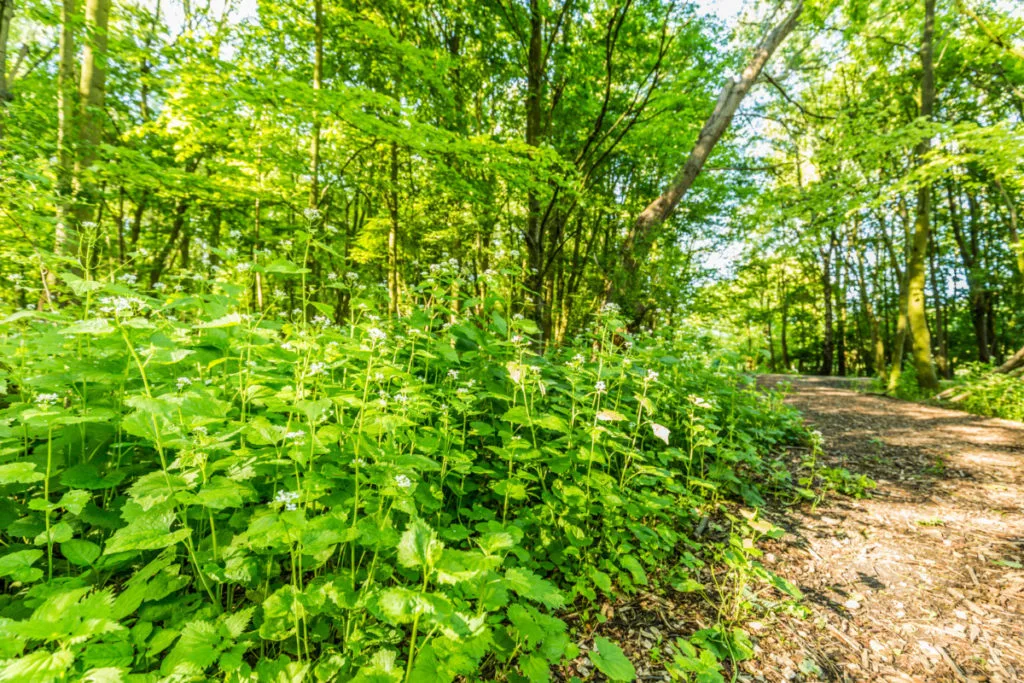
Garlic mustard grows everywhere and spreads like crazy. It grows on the edges of forests and lawns, and sometimes in fields. It loves disturbed soil. If you’ve seen it around, you know how prolific it is. It has a few built-in do-not-compete mechanisms.
- Garlic mustard’s roots release a natural compound into the soil, preventing neighboring seeds from germinating and preventing mycorrhizae (helpful soil fungi) from growing.
- The seeds can stay viable for up to twelve years.
- Pests and diseases that naturally keep it in check simply aren’t found here in the states.
- And its flavor is less appetizing to grazing animals like whitetail deer, meaning it gets picked over while other plants are eaten.
Garlic mustard has a free ride here, and it’s taking over.
Garlic mustard is the ultra-competitive kid that singles you out every time you play dodge ball in gym class and lobs the ball at your head. (Who came up with this game anyway?)
And while you can’t eat the ultra-competitive gym class kid, you can eat garlic mustard.
Hmm, I’m having second thoughts about that comparison now.
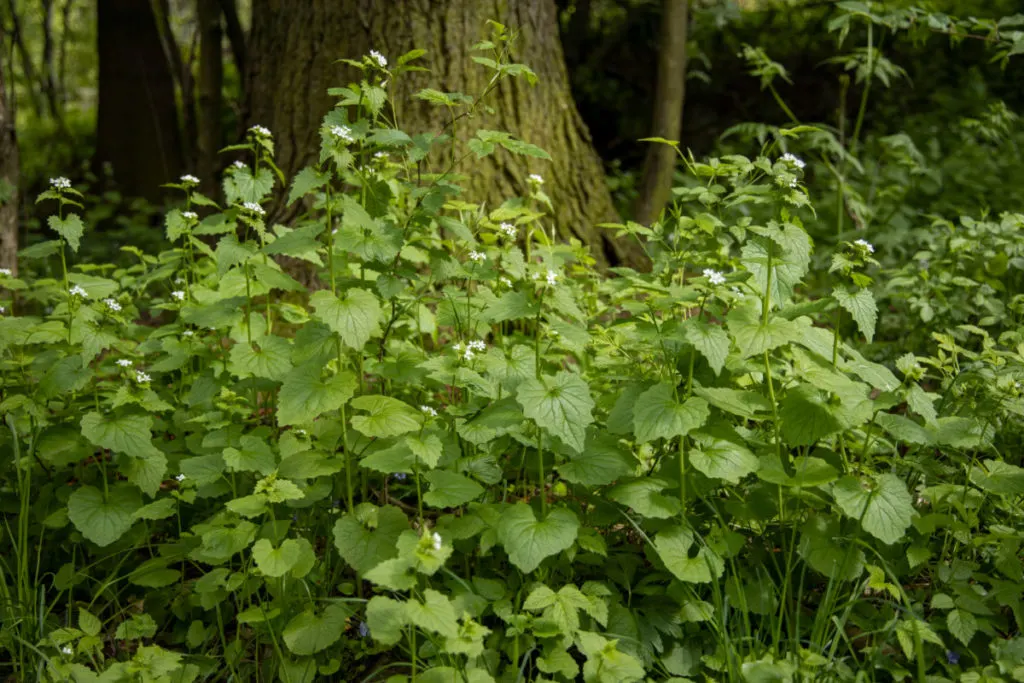
Why should you eat garlic mustard?
Despite its bad behavior in the plant world, it’s hands down my favorite thing to eat in the spring. Hopefully, once I’ve convinced you to taste it, it will be yours too. While you’re out there saving the world from garlic mustard invasion, pick some purple dead nettle too, or any one of these popular early spring wild foods.
Because it’s got such a bad reputation as an invasive plant, you can harvest garlic mustard as much as you want. In fact, it’s encouraged. Seriously, we could probably eat it every day and still not make a dent in the problem.
When it comes to identifying this plant, it throws some people for a loop, not because it’s difficult to identify, but because it’s a biennial.
The first time I went looking for it, I remember seeing two different plants growing close to one another. Both seemed to fit the description of garlic mustard, but they were clearly different. So, I grabbed a handful of each and asked my trusted foraging mentor, “Which one is garlic mustard?”
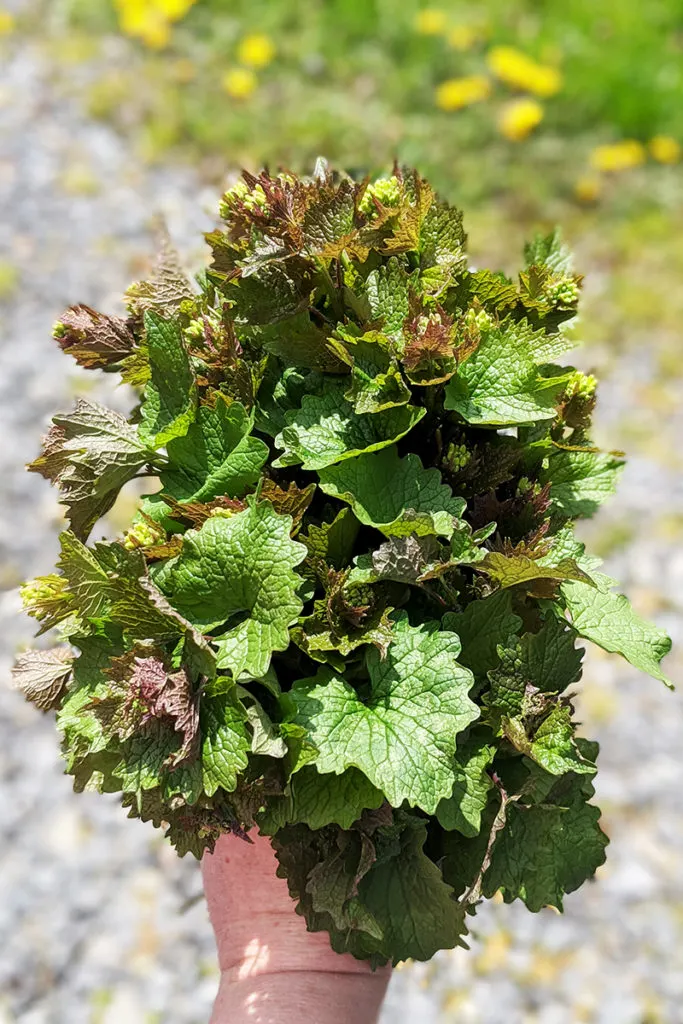
“Both,” she said.
Huh, okay.
Garlic mustard has a lifespan of two years and looks different each year.
It starts life in the summer or fall, popping up as a lovely rosette (it grows in a circle of leaves radiating out from the center, like dandelions) with small heart-shaped leaves with scalloped edges and thin reddish stems.
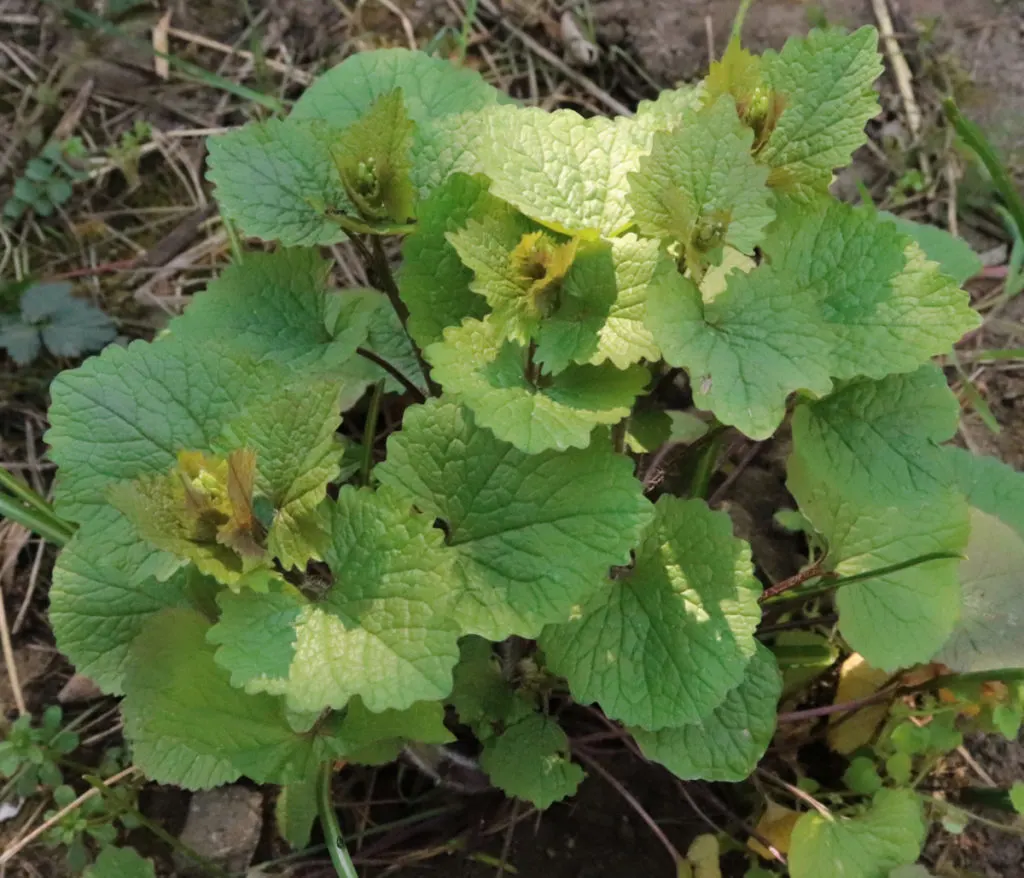
It hangs out over winter, saving its strength for the next year. In the spring of its second year, it will produce a stalk with a flower head on it. The leaves on the second-year growth are less heart-shaped and more of a triangle. These flower stalks can grow between 2 to 3 feet high.
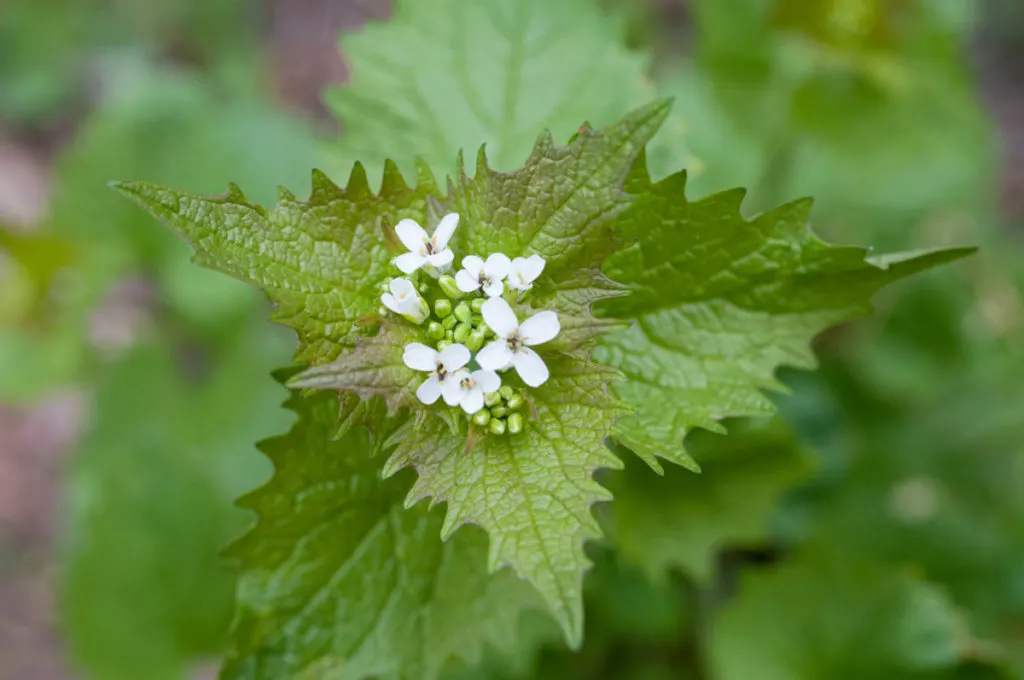
When you look closely, the closed flower heads look a bit like tiny broccoli heads. The leaves surrounding them may have a slight reddish blush to them. These will open up to reveal tiny white flowers, and from there, it will develop seed pods that will drop and continue its quest for world domination.
The good news is no matter what stage of its life cycle you stumble upon it; it’s always got good parts to eat. Garlic mustard is a mustard family member (shocking, right?) and has a flavor profile of, well, I think that’s obvious. From a culinary standpoint, it’s a wonderful bitter green. And it’s free!
New Rosettes
When you find a patch of new garlic mustard, you’re duty-bound to yank those buggers up before they can even get to their second year. The tender leaves make a killer pesto, much different than your traditional basil pesto. Garlic mustard pesto is spicier and all the better for it.
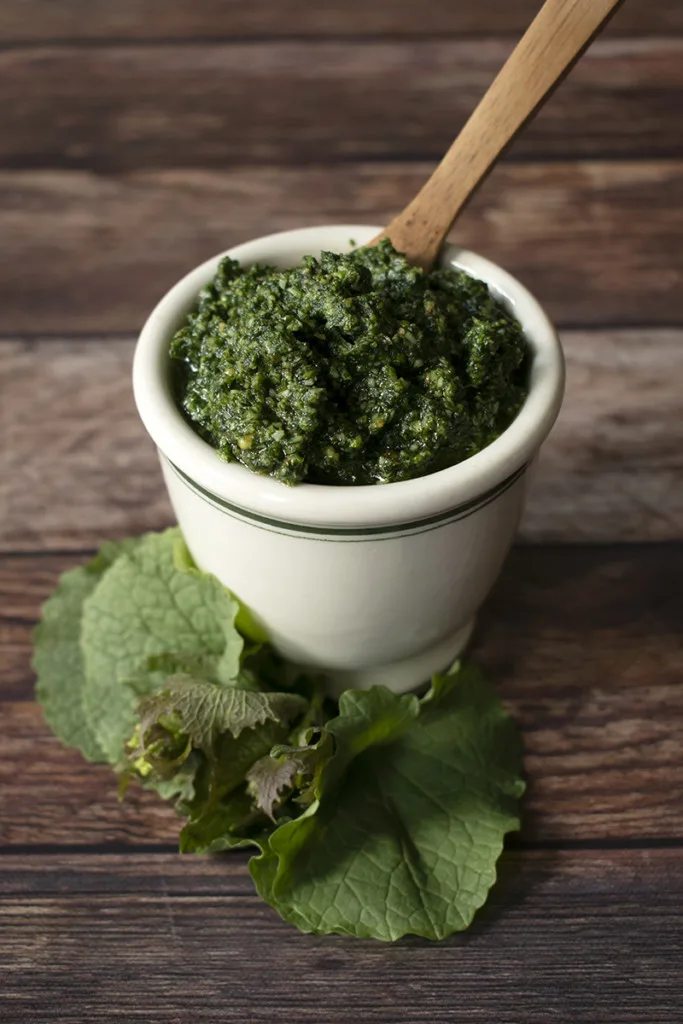
You can get my full garlic mustard pesto recipe (and a few other easy to forage recipes) here.
Eating the Seedpods
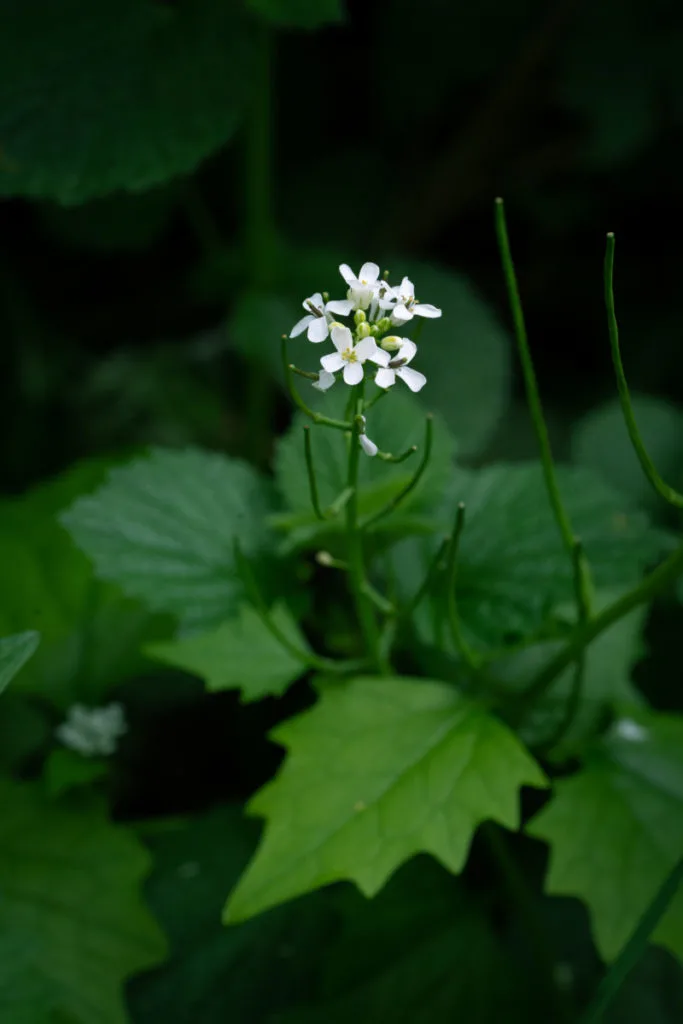
You can eat the seedpods raw. It’s not my favorite way to eat garlic mustard, but when you’re in the woods and hungry, they’ll do in a pinch. They’re also pretty good tossed in a salad.
Eating the Seeds
You can use the seeds for cooking much like you would mustard seeds. However, if you’re going to collect the seeds, you need to be careful that you aren’t spreading them. Snip the seedpod heads off the plant with scissors directly into a paper bag.
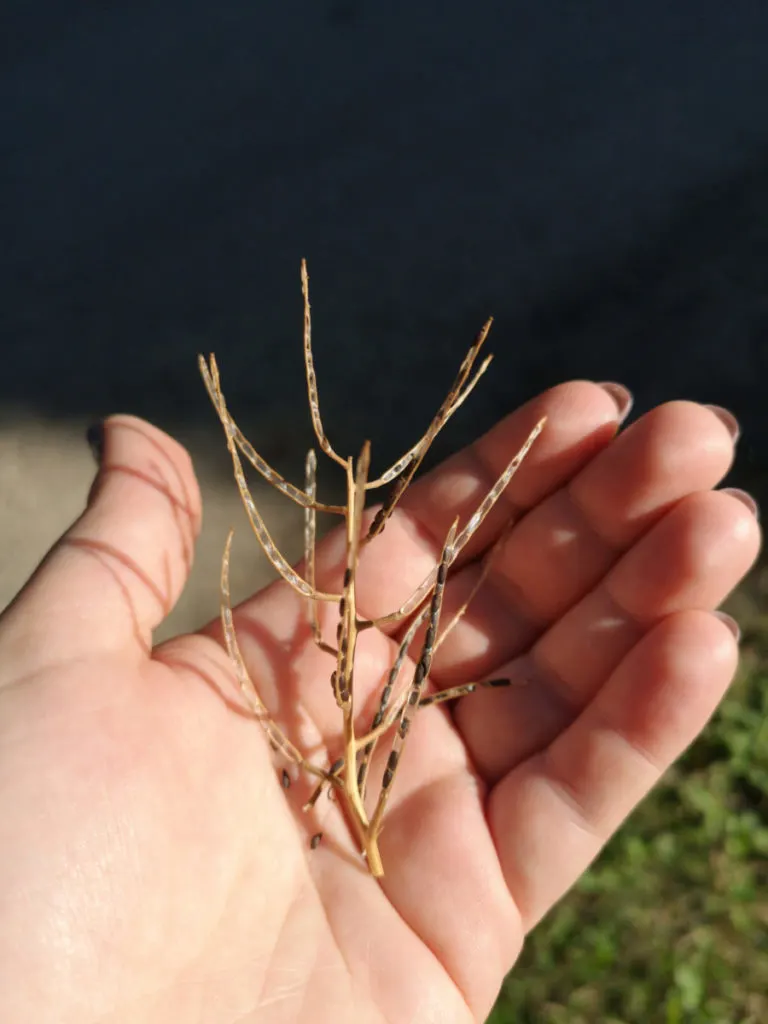
Once home, put the paper bag somewhere warm and let the seedpods dry out for a few days. Once the pods are papery and dry, roll the paper bag closed and give it a good shake. The seeds should fall away from the dried pods. Discard the empty seedpods in the trash, don’t compost them or toss them outside.
Toast the seeds for a few minutes in a dry, warm skillet, let them cool and use as you would mustard seed.
Lay the seedpods out on a baking rack to dry out for a few days
Eating the Second Year Growth
When foraging second-year growth, the heads of the flowers are best when they’re still tightly closed or only have one or two tiny flowers on them. The stems are quite tender and tasty at this point too.
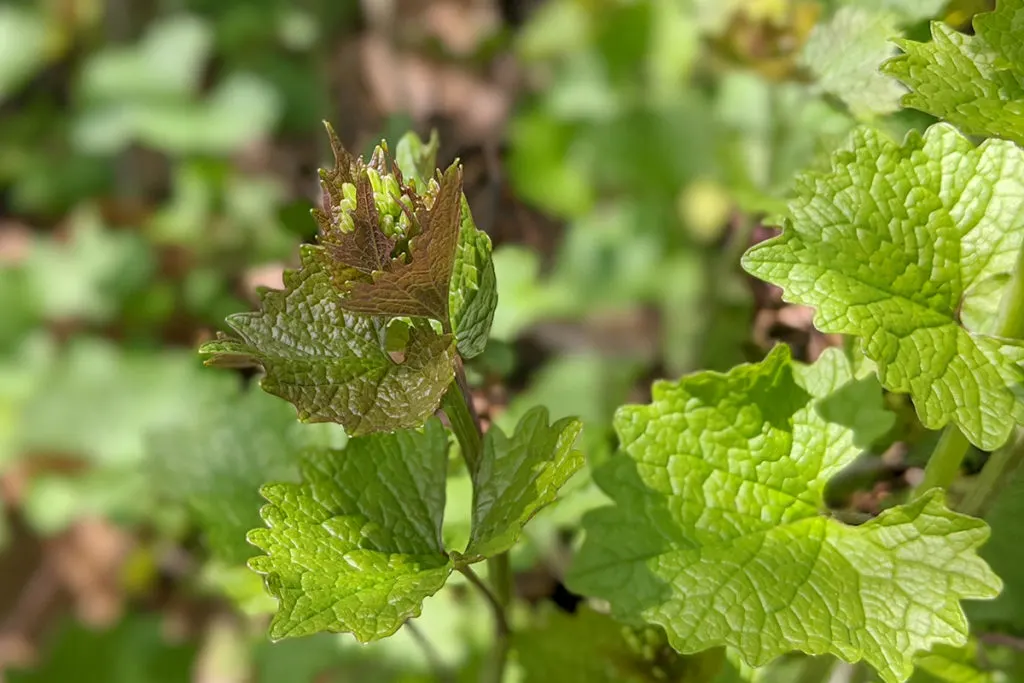
Pick the first 6-10 inches of growth. If you have a hard time snapping the stem, it’s too tough, move further up the stem.
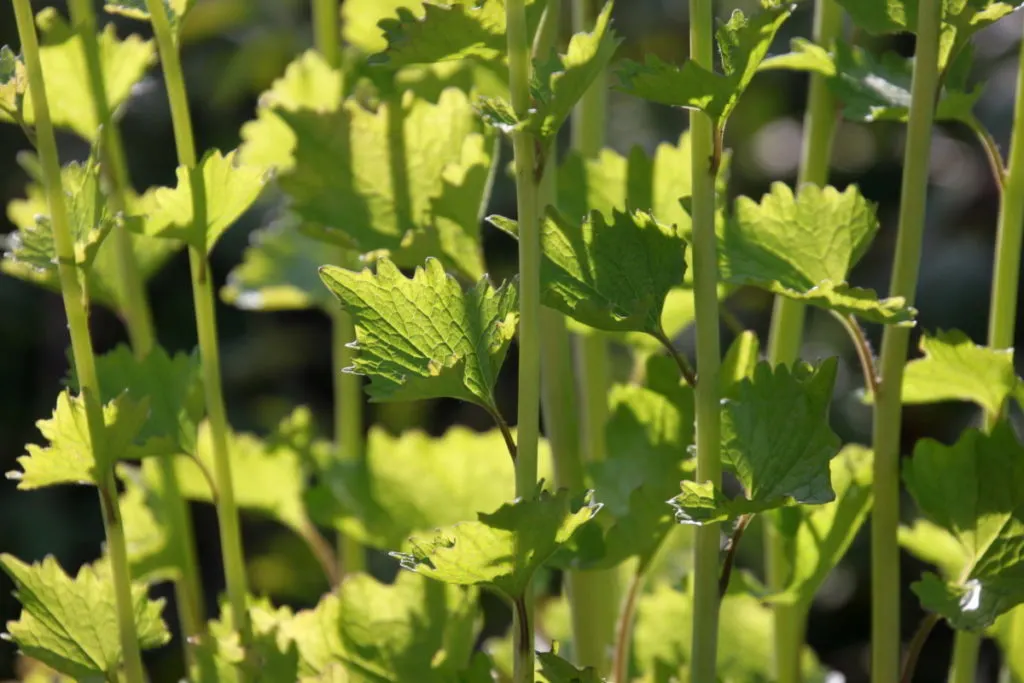
Sautéed Greens
I love to cook it like I would broccoli rabe sauteed with lots of olive oil and red pepper flakes. Add in a dash of soy sauce or a spritz of lemon, and it’s the perfect foraged side dish.
Tossed with Pasta
Or use your sauteed greens with pasta, olive oil, and freshly grated parmesan cheese for a fresh, bitey spring pasta dish – the perfect segue from a winter full of heavy foods.
Amazing White Pizza
The sauteed greens also make an incredible white pizza. Slather a prepared pizza crust with ricotta cheese, then place the greens on it. Top the whole thing off with plenty of fresh homemade mozzarella and a drizzle of olive oil before cooking it in the oven.
Don’t Forget the Roots
The roots of mustard garlic are similar to horseradish, albeit much smaller. They’re also a bit stringy, like ginger, so you need to chop them up well.
You can make an alternative to horseradish by tossing cleaned mustard garlic roots into a food processor and pulsing them. Add enough white vinegar to keep the mixture moist and store in a sealed jar in the fridge.
Or try infusing vinegar with the chopped-up roots. In a clean jar, add finely chopped garlic mustard roots and enough vinegar to cover them, plus 2”. Seal the jar and let it steep somewhere cool and dark, like a cupboard. After a month, strain the vinegar and use this spicy vinegar on greens and stir-fries or to flavor rice.
I don’t think we’re going to get rid of garlic mustard anytime soon, but I think the more people who start eating it, the better chance we have of slowing its spread. And from a health standpoint, wild food is always more nutritionally dense than the food we grow ourselves. If you’re out for a walk and see this noxious weed, remember it’s still pretty tasty in the kitchen.
And finally, one of my favorite spring foraging secrets – most of the time you can find all five of these easy-to-forage foods within yards of each other. So keep your eyes peeled for more than just garlic mustard.

Get the famous Rural Sprout newsletter delivered to your inbox.
Including Sunday musings from our editor, Tracey, as well as “What’s Up Wednesday” our roundup of what’s in season and new article updates and alerts.

